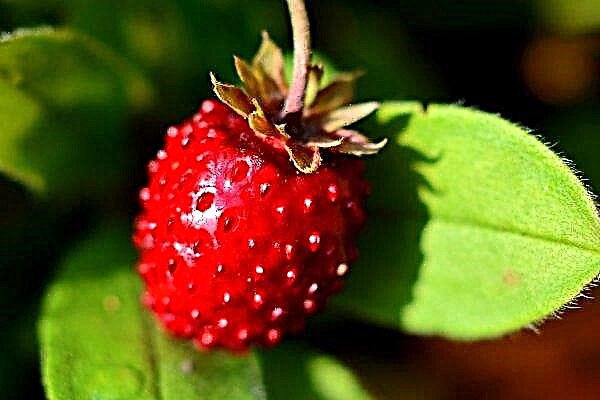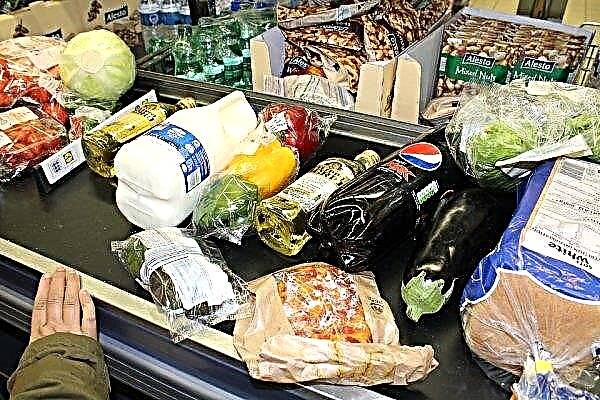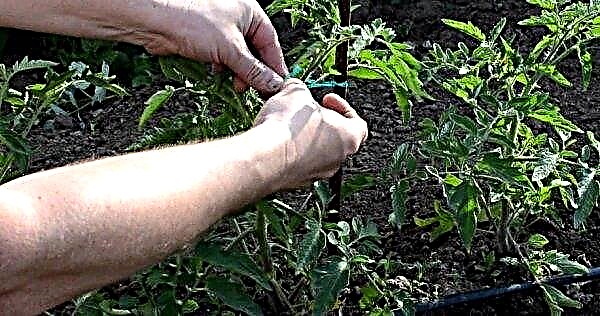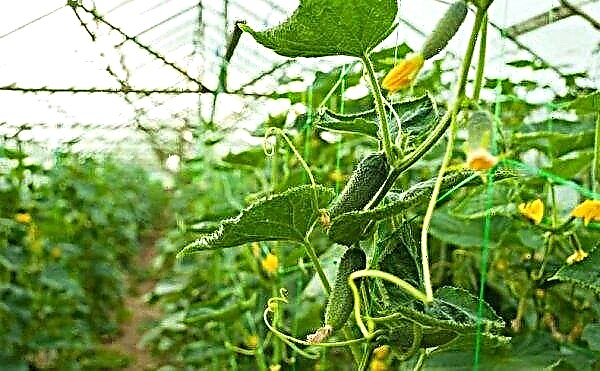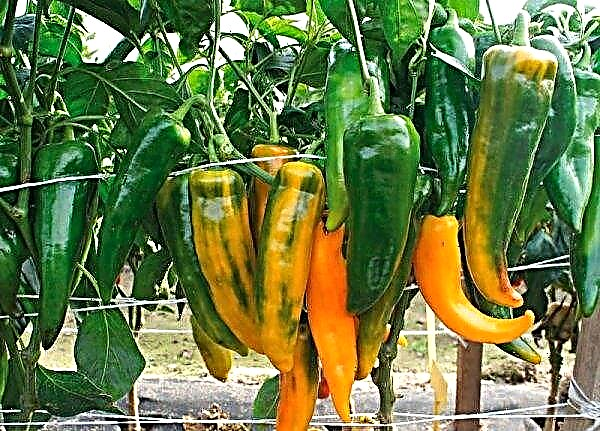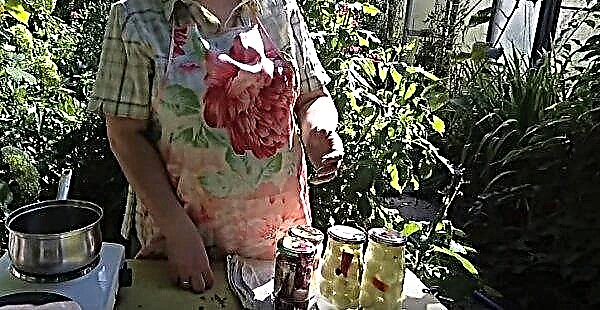Bell pepper is considered a rather capricious crop, which is often affected by infections. The fight against the disease should begin immediately after the discovery of the first signs. The article identifies the most common problems that occur during the cultivation of sweet pepper.
Bell pepper diseases and their treatment
This culture is sick with viral, bacteriological and fungal diseases (most often due to a violation of the culture care technique). First of all, they establish the cause, and then they take measures.
Fungal
This group of diseases is the most common. Spores of fungi are tenacious, they can occur after 3-15 years in the presence of favorable conditions. Transmitted by pests, by air, by microorganisms.
The main preventive measure against fungal diseases is the strict observance of agricultural techniques for growing crops.
Important! In case of defeat by several species of mushrooms, the bush is immediately removed from the garden and burned.
Blackleg
The disease appears as a result of the activity of fungi that live in the upper layer of the soil and feed on organic waste.
Plants can become ill for the following reasons:
- sudden change, temperature fluctuations;
- waterlogging of the soil;
- lack of light;
- thickening of landings;
- watering with ice water;
- heavy soil with high acidity.
The fungus infects only young shoots and is not dangerous after the appearance of 2-4 true leaves. If a black leg has formed, grown seedlings may be affected.
The name itself speaks about the main signs of this disease: the stem from the bottom blackens, decays, then dries out.
To combat the disease, affected seedlings are removed. Seedlings are treated with "Fitosporin", "Barrier" or "Bactofit." Copper sulfate, copper oxychloride, Bordeaux liquid, potassium permanganate solution effectively fight the fungus.
Gray rot
It is formed on the basal zone of seedlings. It is expressed as a thin white film at the base of the stem at all stages of plant maturation, as well as putrefactive gray spots. One of the reasons for the development of the disease is an excess of moisture. In the rainy season, air humidity can exceed 80%. To the appearance of gray rot affect too thick plantings, violation of the temperature regime (below + 15 ° C) or predecessors suffering from the same ailment.
Did you know? The severity of pepper is measured according to the Scovilla table. Sweet pepper has a hotness in the range of 0-100 points. Cayenne - 30,000-50,000 units. The Carolina Reaper variety is considered to be the most acute, the level of stickiness of which reaches 2,200,000 points.
To treat the disease, all affected plants are removed, and the remaining ones are treated with a solution based on garlic or garlic arrows. The mixture is prepared in this way: 100 g of garlic cloves are chopped, 50 ml of vegetable oil and 6 ml of liquid soap are added. Suspension insist 24 hours. This mass is diluted with water (2 tbsp. Per 1 liter of water) and plants are sprayed.
If there is an urgent need for treatment against gray rot, healthy bushes are pollinated with crushed coal tablets or chalk. It is allowed to treat pepper with Fitosporin, Barrier or fungicides.
Cladosporiosis
The second name of the disease is brown spotting. All fragments of pepper are affected: leaves, ovaries, peduncles.
The main signs of cladosporiosis:
- light green specks with a touch of mold on the inner side of the leaves (mainly in the lower tier);
- green or dark brown spots on the outside of the leaf;
- leaf damage occurs quickly from top to bottom;
- foliage fades and withers.
Cladosporiosis is transmitted through the soil, a working tool and the remains of plants. Through the seed, the disease is not transmitted.Did you know? Bell pepper, like chocolate, contains endorphin. Only the benefits of the vegetable are an order of magnitude greater: it is less nutritious and more fortified.

At the initial symptoms of the disease, the plants are sprayed with cupricol (this is a fungicide) or another copper-based agent.
If the disease arose during the ripening of the fruit, chemical preparations are not recommended. It is better to use folk remedies: 1 cup chopped garlic, dilute in 3 liters of water and stand for 10 days. Before use, 1 cup of the resulting suspension is diluted in a bucket of water and sprayed over pepper.
Late blight
Most often affects late varieties. The disease usually develops in late summer, when it is warm enough during the day and cold at night. Late blight affects the stems and leaves of the plant. It is not difficult to determine the problem: large brown spots appear on the edges of the sheet, and a white coating appears on the back of the plate, which contains the spores of the pathogen.
The infected plants dry quickly, the fruits rot and blacken (signs appear even on the harvested crop). Most often, the pathogen enters the crop from nearby potato plantings.
To the question of how to treat late blight, and whether there are effective methods, the answer is yes. You can deal with the problem by spraying with copper-based drugs. Plants are treated from the moment the first signs appear (with a frequency of 2-4 times in 1-2 weeks).
Among the chemicals effective against late blight are considered: "Oksikhom", "Alirin-B", "Barrier", "Barrier".
Important! Resistance to late blight increase phosphorus-potassium top dressing.
Powdery mildew
It rarely affects seedlings and appears mostly in conditions of overmoistening of the soil and thickening. You can determine the disease by the whitish points on the leaves. Later, the plate deforms. If the fight does not start in time, the whole plant becomes infected, the bush dries and dies. It is destroyed, the soil is treated with a manganese solution, and the remaining bushes are sprayed with fungicides (for example, Ridomil Gold).
White rot
Infection occurs through the soil, and the infection itself at a temperature of + 12 ° C - + 15 ° C spreads quite quickly.
Fungal stimulants can be:
- sharp fluctuations in temperature;
- high humidity;
- oversaturation of the soil with nitrogen;
- lack of air.
Key symptoms of the lesion are:
- withering of the upper part;
- the leaves become discolored, become watery and are covered with a whitish coating;
- the stalk rots in the basal zone;
- black sclerotia of the fungus appears inside the stem.
Important! The treatment of plants with white rot fungicides is carried out only before fruiting and after harvest.
The infection should be combated comprehensively, including agricultural practices, folk methods and chemicals. The infected areas are cut off, treated with a mixture of crushed chalk and potassium permanganate solution.
Of the finished drugs use:
- copper sulfate;
- Abiga Peak;
- Bordeaux liquid;
- "Oksikhom."
Bacterial
Such disorders are caused by bacteria that infect plants in various ways.
Black spotting
A rarely occurring disorder that affects young seedlings and only open leaves. At the very beginning of the disease, individual black specks are noticeable on seedlings, but over time their number increases. If you do not fight the spotting, the plant will die.
The causes of the problem areas are thickened plantings, contaminated soil and the use of low-quality seed material.
As a preventive measure, it is recommended to water the earth with a dark pink manganese solution and periodically treat the plantings with Fitosporin. The infected bushes should be burned.
Bacterial cancer
The disease affects seedlings growing in a greenhouse environment. Its reproduction is promoted by a constantly elevated level of humidity, high temperatures (+ 25 ° C- + 35 ° C), overly tight planting and excessive watering. The bacterium is transmitted through work tools, hands and through insects.
Bacterial cancer affects leaves, shoots and fruits. Dark brown areas of anomalous form appear in the infected areas, in the middle with a lighter color. Subsequently, the specks are combined into one continuous spot 1-3 cm in size, of elongated shape. Everything is covered with a crust.Important! In greenhouse complexes where the disease was observed «bacterial cancer», in the off-season, the soil is decontaminated or completely replaced.
Before starting the fight, healthy bushes are treated: every morning they are sprayed with copper-containing compounds (vitriol, cupricol). Then the affected plants are removed.

Bacterial rot
This microorganism affects all segments of pepper: fruits, foliage, roots, stems. Leaking into the vascular system, bacteria clog them, taking food from single parts of pepper. As a result, the branches first wilt, and then the entire bush.
The main symptoms of bacterial rot:
- discoloration of the stem;
- hollow shoots;
- chlorosis (decreased chlorophyll) and leaf necrosis;
- the appearance near the stalks of depressed watery areas of a brown hue.
For prevention, it is necessary to disinfect the soil, thoroughly clean the area from plant waste, and pickle seed. If these measures are neglected, the future crop will be lost.Did you know? America is considered the birthplace of sweet pepper. There, this plant grows in the form of perennial shrubs and does not require special care.
There are no specific treatments for bacterial rot. Sick plants clean and thoroughly disinfect the soil using boron, manganese and copper sulfate.

Viral
This kind of disease is usually carried by insects. For viral diseases, the formation of spots on the leaves, pathology in the development of the plant, and the acquisition of a painful appearance are characteristic. Withering is not observed, but it is necessary to deal with the disease. Otherwise, you can lose the crop.
Stolbur
The affected pepper turns yellow, the fruits grow small and have an abnormal shape. The cause of the disease are insects, which, drinking juice from a plant, transmit the columnar virus.
The disease is detected by the following symptoms:
- drying out foliage;
- unnatural form of fruit;
- inhibition of plant growth;
- yellowing leaves.
Complex fertilizers will also be useful, which will increase the immune forces of the plant. If pepper is grown in greenhouse conditions, the soil is treated with a “Barrier” or “Barrier”.

Tobacco mosaic
The causative agent of this disease is the tobacco mosaic virus. A pathogen is dangerous with high infectivity and resistance (under suitable conditions, it remains viable for 50 years).
At the very beginning, the disease is detected in the form of vein necrosis and the appearance of a mosaic on the leaves, which quickly spread over the entire surface and inhibit the growth of pepper. The virus is transmitted by sucking insects and ticks, and in greenhouse conditions, infection can occur through inventory.Important! Crop losses can reach up to 90%.
To prevent the disease, it is recommended to adhere to the rules of cultivation, and before planting, heat the seed at a temperature of + 70 ° C. The soil before planting can be treated with extracts of aloe juice, and from the preparations - "Chrysomalom".

Pests and control of bell pepper
Along with diseases, pests sometimes cause enormous damage to pepper, so they should be identified in a timely manner and the fight should begin as early as possible.
Aphid
This is a small dangerous insect. There is always a lot of it. Aphid causes tremendous harm, affecting all parts of the plant: stem, flowers, leaves.
If this pest has appeared in the greenhouse or in the garden, then the plants must be urgently treated with instant insecticides (Karbofos, Decis, Celtan). Dosage - 1 tbsp. l funds for a bucket of water. Sprayed before buds open and after. During the ripening period, peppers are not sprayed.
A folk remedy based on tobacco dust or vegetable ash has proven itself well. Ashes are bred in a bucket of hot water and insisted day. Before use, the solution is filtered, add liquid soap for gluing and stir. Processed pepper in the morning, before the heat.Did you know? Black ants are to blame for the reproduction of aphids. These insects are considered shepherds of small pests. Therefore, you need to fight not only with aphids, but also with ants.

Ticks
No less dangerous pest that drinks the juice of plants, provoking the fall of leaves, fruits and flowers.
For treatment, a composition based on onion or garlic is used. A glass of raw materials is mixed with liquid soap (10-15 g), dandelion leaves and diluted in a bucket of water. The composition is insisted, filtered and sprayed with the affected pepper.
In the fight against ticks, bleach (200 g per standard bucket of water), soap solution and ready-made preparations (Fufanon, Fitoverm, Actellik, Iskra Bio, Karbofos, Fosbetsid) are suitable.
Slug
These mollusks feast on the grown fruits. If the slugs are not eliminated, they can destroy the entire crop. These pests infect the bushes so that they rot and die.
Chemicals are rarely used against slugs - these mollusks can be bred in a more gentle way. The simplest is the construction of a fence around the plant. A shaft is erected from a mixture of sand and lime. Slugs cannot overcome such an obstacle because it burns them. The stores sell the finished drug against slugs - “Arrow”.
Gardeners who adhere to a natural pest control formula recommend that the soil be treated with burning substances (ground pepper, mustard). Between the bushes you can plant parsley (this spice really does not like shellfish). It is also advised to pour coffee grounds and sprinkle with sawdust on top.
Preventive measures
The problem is easier to prevent than to deal with it later. This is also true for growing peppers. That is why it is necessary to prevent various causes that contribute to the infection of the plant.
The most effective measure is the strict observance of agricultural regulations, including:
- Correct crop rotation. Vegetables are planted in areas where cultures of this family did not grow before. Peppers are not grown in beds where potatoes or tomatoes were grown last season.
- Seed preparation. Seeds are taken only from reliable suppliers, and they must be decontaminated before planting. Sunflower seeds are kept in a manganese solution for 15-20 minutes and 10 hours (not less) - in a special tool (Zircon is suitable).
- Proper placement of seedlings. After planting in open ground, seedlings experience stress for the first 2 weeks. To prevent immunity from this, the seedlings are pre-tempered. It is possible to transfer seedlings to an unprotected area after warm weather is established, the soil warms up. When planting, seedlings are placed shallow so as not to damage the root neck.
- Watering Compliance. Ideal temperature and humidity are easier to maintain in greenhouse conditions. Attentiveness to watering in an unprotected space can prevent the formation of rot.
- Providing heat and light. Since peppers are a heat-loving culture, it suffers from cool nights.To create favorable conditions, the beds are placed in sunny areas, and when the temperature drops, the bushes are covered with a film at night.
Bell pepper has enough enemies, but every problem is easier to prevent than to cure. Following all the recommendations, it is quite possible to get a decent harvest in the garden.


